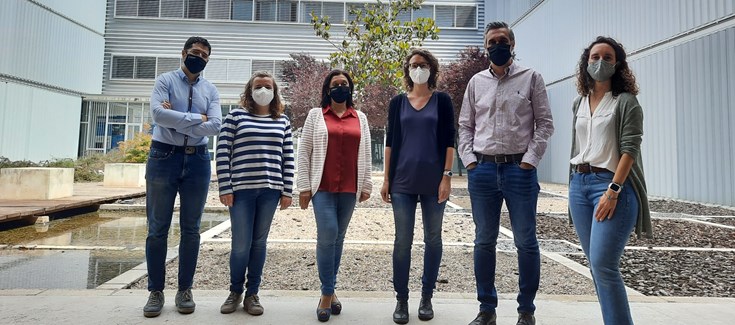New drug delivery system for prolonged pain relief
The management of musculoskeletal pain is a key challenge due to the short duration of anesthetic effect produced by existing clinical treatments, in addition to their potential side effects. Researchers from the CIBER-BBN, the Institute of Nanoscience and Materials of Aragón (INMA), CSIC-University of Zaragoza and the Institute of Health Research of Aragón (IIS Aragón), in collaboration with researchers from the Faculty of Veterinary Medicine of the University of Zaragoza and with participation of NANBIOSIS Unit 9 Synthesis of Nanoparticles Unit, have developed nanogels loaded with nanocrystals of bupivacaine (an anesthetic commonly used in epidural anesthesia and in the control of postoperative pain) obtaining a high drug content for a prolonged duration of local anesthesia.
These nanogels are an alternative to the most prescribed analgesics (antipyretics, steroids and opioids), which frequently present adverse effects such as nausea, vomiting, dizziness and physical dependence, among others. They consist of a biocompatible polymer derived from polyethylene glycol (PEG) that has heat-sensitive properties, so that they would be injected at room temperature and upon reaching body temperature after administration they undergo a change in their structure, resulting in a reduction in their volume. and transforming into a hydrophobic structure, thus controlling the release of the drug encapsulated within.
According to Manuel Arruebo, INMA-CIBER-BBN researcher, “we have validated this new way of dispensing the local anesthetic both in cell cultures and in animal experiments, showing that it increases the duration of sciatic nerve block twice compared to the same dose of free anesthetic. The synthesis of the drug nanocrystals has been carried out in NANBIOSIS U9 (from CIBER-BBN and University of Zaragoza) thanks to the wet chemical synthesis systems of the platform“.
The prolonged duration of anesthetic action can be explained by the regional immobilization of the nanogels at the injection site around the sciatic nerve due to their hydrophobic nature, preventing the diffusion of drug particles and their rapid elimination while interacting efficiently with the tissues thanks to to its temperature-induced conformational change. Studies have shown that this delivery system has low toxicity and does not give rise to an inflammatory response due to the slow release of the drug and the high biocompatibility of the polymer used.
The encapsulation of drug nanocrystals is a promising strategy, which allows reducing the total amount of drug necessary to produce pain relief with the consequent benefits obtained from the reduction of toxicity.
For their part, the researchers Teresa Alejo (INMA) and Víctor Sebastián (CIBER-BBN-INMA) affirm that “through these systems we seek to obtain an effective vehicle capable of prolonging the anesthetic effect in its place of action, avoiding as far as possible the side effects. In this way, they could be used to avoid systemic administration, reduce high concentrations in the blood and reduce the unwanted side effects of some conventional treatments, since they allow to control the release of the drug within the desired therapeutic range, avoiding the consequences of an excess of drug and the negative effects that this implies ”.
Likewise, with this technique the satisfaction and comfort of the patient is considered, since with a single dosage a prolonged therapeutic effect would be achieved. In Europe, with more than 500 million days of sick leave per year, musculoskeletal pain causes almost 50% of all absences from work lasting at least three days and 60% of permanent absences from work. Consequently, pain has a huge impact on work productivity. Some data indicate that the annual cost of pain is greater than the cost of heart disease, cancer and diabetes.
Therefore, the development of an effective injectable local anesthetic with a prolonged duration of action can improve the quality of life of patients affected by these diseases.
Article of refernce:
Teresa Alejo, Laura Usón, Guillermo Landa, Martin Prieto, Cristina Yus Argón, Sara García-Salinas, Ricardo de Miguel, Ana Rodríguez-Largo, Silvia Irusta, Victor Sebastián, Gracia Mendoza and Manuel Arruebo. Nanogels with High Loading of Anesthetic Nanocrystals for Extended Duration of Sciatic Nerve Block, ACS Appl. Mater. Interfaces, 13, 15, 17220–17235. 2021 April 6. [DOI]









